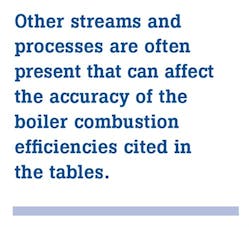The use of tables to determine boiler combustion efficiency for a given fuel based on the excess oxygen and temperature rise above ambient conditions was previously discussed. However, accurate determination of boiler combustion efficiency using tables may not be possible under other circumstances and operating conditions, especially in larger and more complex boiler operations.
For example, the use of alternate fuels that have heating values inconsistent with those used to calculate the efficiencies in the tables will invalidate the assumptions made to produce the tables, often reducing accuracy to the extent of rendering the tables useless. Likewise, the heating value of nonpurchased fuels and wastes introduced into boilers and incinerators can vary all over the map. Negative heating values can occur when additional energy is required to vaporize and destroy wastes such as wastewater.
In addition, other streams and processes are often present that can affect the accuracy of the boiler combustion efficiencies cited in the tables. For example, a significant amount of heat loss can occur because of boiler blowdown that is dependent on the quality of the feedwater (determined by the design and operation of the raw feedwater treatment system), the amount of condensate returned to the boiler, the amount of contaminate introduced into the condensate return and the chemical control of the water in the boiler, among other influences. Soot blow operations similarly cause heat losses (albeit relatively small) that the tables do not address.
In general, more complicated operations usually invalidate the efficiency calculations used to generate the tables and render them of limited or no use.
More next month.
David W. Spitzer is a regular contributor to Flow Control magazine and a principal in Spitzer and Boyes LLC, which offers engineering, seminars, strategic, marketing consulting, distribution consulting and expert witness services for manufacturing and automation companies. Spitzer and Boyes is also the publisher of the Industrial Automation INSIDER. He has more than 40 years of experience and has written more than 10 books and 350 articles about flow measurement, instrumentation and process control. Spitzer may be reached at 845-623-1830 or via spitzerandboyes.com. Click on the “Products” tab to find his Consumer Guides to various flow and level measurement technologies.



